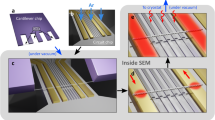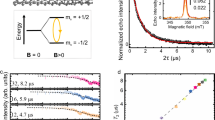Abstract
The ability to tune local parameters of quantum Hamiltonians has been demonstrated in experimental systems including ultracold atoms1, trapped ions2, superconducting circuits3 and photonic crystals4. Such systems possess negligible disorder, enabling local tunability. Conversely, in condensed-matter systems, electrons are subject to disorder, which often destroys delicate correlated phases and precludes local tunability. The realization of a disorder-free and locally-tunable condensed-matter system thus remains an outstanding challenge. Here, we demonstrate a new technique for deterministic creation of locally-tunable, ultralow-disorder electron systems in carbon nanotubes suspended over complex electronic circuits. Using transport experiments we show that electrons can be localized at any position along the nanotube and that the confinement potential can be smoothly moved from location to location. The high mirror symmetry of transport characteristics about the nanotube centre establishes the negligible effects of electronic disorder, thus allowing experiments in precision-engineered one-dimensional potentials. We further demonstrate the ability to position multiple nanotubes at chosen separations, generalizing these devices to coupled one-dimensional systems. These capabilities could enable many novel experiments on electronics, mechanics and spins in one dimension.
This is a preview of subscription content, access via your institution
Access options
Subscribe to this journal
Receive 12 print issues and online access
$259.00 per year
only $21.58 per issue
Buy this article
- Purchase on Springer Link
- Instant access to full article PDF
Prices may be subject to local taxes which are calculated during checkout




Similar content being viewed by others
References
Bloch, I., Dalibard, J. & Nascimbène, S. Quantum simulations with ultracold quantum gases. Nature Phys. 8, 267–276 (2012).
Blatt, R. & Roos, C. F. Quantum simulations with trapped ions. Nature Phys. 8, 277–284 (2012).
Houck, A. A., Türeci, H. E. & Koch, J. On-chip quantum simulation with superconducting circuits. Nature Phys. 8, 292–299 (2012).
Aspuru-Guzik, A. & Walther, P. Photonic quantum simulators. Nature Phys. 8, 285–291 (2012).
Cao, J., Wang, Q. & Dai, H. Electron transport in very clean, as-grown suspended carbon nanotubes. Nature Mater. 4, 745–749 (2005).
Jorio, A., Dresselhaus, G. & Dresselhaus, M. S. (eds) in Carbon Nanotubes: Advanced Topics in the Synthesis, Structure, Properties and Applications 455–493 (Springer, 2008).
Yao, Z., Postma, H. W. C., Balents, L. & Dekker, C. Carbon nanotube intramolecular junctions. Nature 402, 273–276 (1999).
Bockrath, M. et al. Luttinger-liquid behaviour in carbon nanotubes. Nature 397, 598–601 (1999).
Deshpande, V. V. & Bockrath, M. The one-dimensional Wigner crystal in carbon nanotubes. Nature Phys. 4, 314–318 (2008).
Deshpande, V. V. et al. Mott insulating state in ultraclean carbon nanotubes. Science 323, 106–110 (2009).
Loss, D. & DiVincenzo, D. P. Quantum computation with quantum dots. Phys. Rev. A 57, 120–126 (1998).
Kuemmeth, F., Ilani, S., Ralph, D. C. & McEuen, P. L. Coupling of spin and orbital motion of electrons in carbon nanotubes. Nature 452, 448–452 (2008).
Buitelaar, M. et al. Adiabatic charge pumping in carbon nanotube quantum dots. Phys. Rev. Lett. 101, 126803 (2008).
Churchill, H. et al. Relaxation and dephasing in a two-electron 13C nanotube double quantum dot. Phys. Rev. Lett. 102, 2–5 (2009).
Kuemmeth, F., Churchill, H. O. H., Herring, P. K. & Marcus, C. M. Carbon nanotubes for coherent spintronics. Mater. Today 13, 18–26 (2010).
Jespersen, T. S. et al. Gate-dependent spin–orbit coupling in multielectron carbon nanotubes. Nature Phys. 7, 348–353 (2011).
Pei, F., Laird, E. A., Steele, G. A. & Kouwenhoven, L. P. Valley–spin blockade and spin resonance in carbon nanotubes. Nature Nanotech. 7, 630–634 (2012).
Sazonova, V. et al. A tunable carbon nanotube electromechanical oscillator. Nature 431, 284–287 (2004).
Leturcq, R. et al. Franck–Condon blockade in suspended carbon nanotube quantum dots. Nature Phys. 5, 327–331 (2009).
Steele, G. A. et al. Strong coupling between single-electron tunneling and nanomechanical motion. Science 325, 1103–1107 (2009).
Lassagne, B. et al. Coupling mechanics to charge transport in carbon nanotube mechanical resonators. Science 325, 1107–1110 (2009).
Sahoo, S. et al. Electric field control of spin transport. Nature Phys. 1, 99–102 (2005).
Jarillo-Herrero, P., Van Dam, J. A. & Kouwenhoven, L. P. Quantum supercurrent transistors in carbon nanotubes. Nature 439, 953–956 (2006).
Hauptmann, J. R., Paaske, J. & Lindelof, P. E. Electric-field-controlled spin reversal in a quantum dot with ferromagnetic contacts. Nature Phys. 4, 373–376 (2008).
Pillet, J-D. et al. Andreev bound states in supercurrent-carrying carbon nanotubes revealed. Nature Phys. 6, 965–969 (2010).
Schindele, J., Baumgartner, A. & Schönenberger, C. Near-unity Cooper pair splitting efficiency. Phys. Rev. Lett. 109, 157002 (2012).
McEuen, P., Bockrath, M., Cobden, D., Yoon, Y-G. & Louie, S. Disorder, pseudospins, and backscattering in carbon nanotubes. Phys. Rev. Lett. 83, 5098–5101 (1999).
Woodside, M. T. & McEuen, P. L. Scanned probe imaging of single-electron charge states in nanotube quantum dots. Science 296, 1098–1101 (2002).
Wu, C. C., Liu, C. H. & Zhong, Z. One-step direct transfer of pristine single-walled carbon nanotubes for functional nanoelectronics. Nano Lett. 10, 1032–1036 (2010).
Steele, G. A., Gotz, G. & Kouwenhoven, L. P. Tunable few-electron double quantum dots and Klein tunnelling in ultraclean carbon nanotubes. Nature Nanotech. 4, 363–367 (2009).
Liang, W. et al. Fabry–Perot interference in a nanotube electron waveguide. Nature 411, 665–669 (2001).
Acknowledgements
The authors thank N. Shadmi and E. Joselevich for nanotube growth in the initial stages of the project, D. Mahalu for electron-beam writing, A. Yoffe and S. Garusi for dry etching and F. Kuemmeth, P. McEuen, H. Shtrikman, F. von-Oppen and A. Yacoby for comments on the manuscript. S.I. acknowledges financial support from the ISF Legacy Heritage foundation (grant 2005/08-80.0), the Bi-National Science Foundation (BSF) (grant 710647-03), the Minerva Foundation (grant 780054), the ERC Starters (grant 258753), the Marie Curie People (grant 239322) (IRG) and the Alon Fellowship. S.I. is incumbent of the William Z. and Eda Bess Novick career development chair.
Author information
Authors and Affiliations
Contributions
All authors conceived, designed and performed the experiments. J.W., S.P., A.B., A.H. and S.I. analysed the data. S.P., A.B. and A.H. contributed analysis tools. J.W. and S.I. wrote the paper.
Corresponding author
Ethics declarations
Competing interests
The authors declare no competing financial interests.
Supplementary information
Supplementary information
Supplementary information (PDF 1556 kb)
Rights and permissions
About this article
Cite this article
Waissman, J., Honig, M., Pecker, S. et al. Realization of pristine and locally tunable one-dimensional electron systems in carbon nanotubes. Nature Nanotech 8, 569–574 (2013). https://doi.org/10.1038/nnano.2013.143
Received:
Accepted:
Published:
Issue Date:
DOI: https://doi.org/10.1038/nnano.2013.143
This article is cited by
-
Nano-assembled open quantum dot nanotube devices
Communications Materials (2024)
-
High-speed identification of suspended carbon nanotubes using Raman spectroscopy and deep learning
Microsystems & Nanoengineering (2022)
-
Imaging hydrodynamic electrons flowing without Landauer–Sharvin resistance
Nature (2022)
-
Deterministic transfer of optical-quality carbon nanotubes for atomically defined technology
Nature Communications (2021)
-
Quantum capacitance mediated carbon nanotube optomechanics
Nature Communications (2020)



